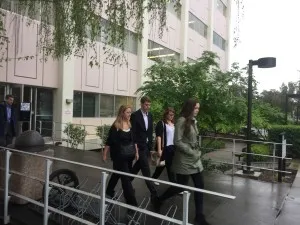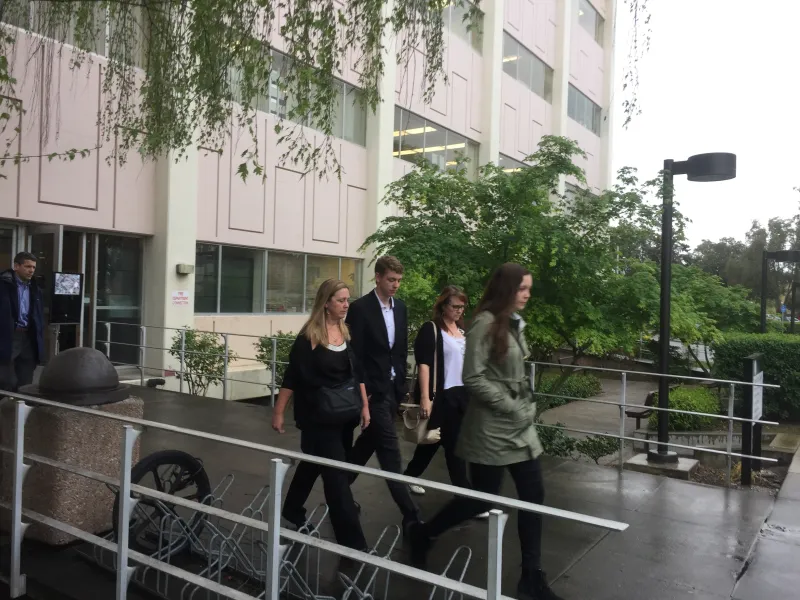
Monday marked the third day of testimonies in the ongoing trial of Brock Turner, the former Stanford freshman and varsity swimmer accused of sexually assaulting an intoxicated, unconscious woman behind Kappa Alpha (KA) fraternity house last January.
Turner’s trial commenced last Monday, March 14 with the selection of the jury, which includes four women and eight men, as well as two alternate jurors, both male. Last Thursday and Friday at the Palo Alto Courthouse, the jury heard testimonies from various witnesses and the alleged assault victim herself, a 23-year-old woman who did not attend Stanford but was on campus for a party at KA the night of the incident. The Daily will refer to the alleged victim as Jane Doe to protect the victim’s identity.
People v. Brock Allen Turner continued on Monday with examinations of Doe, her sister and expert witnesses, including a forensic scientist who said that Turner’s finger swabs contained DNA matching the alleged victim’s.
Thursday and Friday
In Thursday’s court session, graduate student Carl-Fredrik Arndt recounted biking to the KA party in the early hours of Jan. 18 and discovering Turner “thrusting” atop an unmoving woman on the ground outside. Arndt said that he and fellow graduate student Peter Jonsson confronted Turner, who attempted to run away. Arndt and Jonsson tripped Turner and held him until police arrived.
Then-nineteen-year-old Turner was arrested that morning and was subsequently charged by the Santa Clara County District Attorney with five counts of felony, later reduced to three: assault with intent to commit rape of an intoxicated or unconscious person, sexual penetration of an intoxicated person and sexual penetration of an unconscious person. “Sexual penetration” is distinct from “rape,” as it involves any object or body part other than a sexual organ.
Following his arrest, Turner withdrew from Stanford and was forbidden by the University to return to campus.
In a police report released last January, Turner admitted to sexual contact with Doe but denied having or intending to have intercourse with her. On Thursday, Turner’s attorney Michael Armstrong maintained his client’s innocence and urged the jury to remember that only Turner “can testify to the entire period of time” under scrutiny.
But Deputy District Attorney Alaleh Kianerci, the prosecutor, emphasized the “helpless” state of Turner’s alleged victim, Doe.
On Jan. 18, an unresponsive Doe was rushed to Santa Clara Valley Medical Center; she did not regain consciousness until 4:15 a.m., approximately three hours after police arrived at the scene outside KA. A blood sample taken at the hospital revealed Doe’s blood alcohol content to be at least three times the legal limit for driving, Kianerci said. Doe testified on Friday that she has no memory of the alleged assault or of meeting Turner.
A police report states that Turner was also intoxicated the morning of Jan. 18 but was responsive to police questioning.
Kristine Setterland, one of the Sexual Assault Response Team (SART) nurses who examined both Doe and Turner shortly after the incident, also testified on Friday. She described abrasions on Doe’s body consistent with “penetrating trauma” but said she could not be confident as to what caused the trauma.
The jury also heard from a friend of Doe’s sister who was at the KA party, as well as Doe’s boyfriend, who recalled a Jan. 18 voicemail message as evidence of Doe’s incoherent state at the time.
Monday
Monday’s court session began with a cross-examination of Doe.
Doe confirmed that she had no memory of brief calls to her sister and her sister’s friend at 12:29 a.m. on Jan. 18. She estimated that her last memory was around midnight.
Armstrong referenced Doe’s earlier testimony that she had sung and acted “goofily” at the party to make her sister laugh and that she had drunk vodka from a red cup. Doe agreed that these actions were, in Armstrong’s words, “decisions [she] made.”
Armstrong then asked Doe if she partied often while in college, as she had told police in a previous interview.
“I did a decent amount — I would not call myself a party animal,” Doe said.
“I’m a social person,” she added later.
Doe confirmed that she had previously experienced four to five blackouts in college as a result of drinking. Asked by Kianerci if the Jan. 18 blackout was different from prior ones, Doe said, “In previous blackouts I have never been half-naked outside.”
Kianerci asked if others had ever described Doe engaging in “promiscuous” behavior during prior blackouts. Doe said no.
Next, jurors heard from Craig Lee, a forensic biologist at the Santa Clara County District Attorney’s Crime Laboratory.
Lee, a 20-time veteran of forensic testimony, examines criminal evidence for the presence of biological materials such as blood, semen, saliva and skin cells. Using the DNA isolated from these biological materials, Lee said, he builds a genetic profile that can be compared to profiles of real individuals.
Lee noted that his tests cannot decisively confirm what type of bodily substance is present. He also said that wetness or the presence of dirt can inhibit accurate DNA analysis.
Lee examined items in SART kits collected from both Doe and Turner, as well as Doe’s underwear, which police found lying on the ground next to Doe when they arrived at KA. Lee detected no semen in the underwear or in vaginal, cervical, rectal and oral swabs taken from Doe.
Lee said it was not possible to test whether skin cells from Turner were present in Doe’s vaginal and cervical swabs.
Lee discovered a mixture of at least two individuals’ DNA on the underwear’s waistband. The DNA present in larger amounts matched with Doe, while the DNA present in smaller amounts did not seem to match with Turner, assuming that it represented the DNA of only one person.
However, Lee did find DNA matching Doe’s in swabs taken from Turner’s finger and fingernails.
Armstrong confirmed with Lee that a forensics scientist cannot tell when DNA analyzed in a sample was placed there.
Shaohsuan “Steven” Fanchiang, a paramedic at the Palo Alto Fire Department, described Doe’s level of responsiveness when he cared for her on the scene at KA. Doe did not respond to the “shake and shout” procedure used to rouse unconsciousness patients and only temporarily opened her eyes after Fanchiang applied “painful stimuli” by pinching hard on her nail beds.
In his report from Jan. 18, he gave her a score of 11 out of 15 on the Glasgow Coma Scale (GCS) often used to assess seriously intoxicated individuals.
At any score below 15, Fanchiang said, “you’re considered altered and unable to make your own decisions.”
Doe vomited before being taken away in an ambulance but was able to spit or cough the vomit out of her throat without assistance.
Alice King — a supervising criminalist for Santa Clara County — also testified. Given nominally hypothetical situations corresponding to Doe and Turner on Jan. 18, King estimated that the Doe and Turner’s blood alcohol content (BAC) levels at 1 a.m. would have been .242 to .249 and .171, respectively.
Finally, Doe’s sister took the stand. Earlier, Doe had called herself more of a mother than a sister to her younger sibling; the sister echoed this in her description of Doe’s demeanor in the hospital the morning of Jan. 18.
“I was really upset, but she was very composed,” Doe’s sister said, fighting tears. “She tends to try to make me feel better. I could tell that she was upset but really worried about me. She kept trying to make jokes.”
The night before, the sister convinced Doe to attend the KA party. She and Doe took shots at home then left for Stanford with friends; at the party, they drank beer. Doe also drank vodka.
The sister said that Turner, whom she did not know at the time, tried twice at the party to kiss her before she pulled away, despite the fact that they never talked that evening. The sister also said she never observed Turner and Doe interacting.
At some point, Doe’s sister left the party to get a highly intoxicated friend into bed on campus. That was the last time the sister saw Doe that night, though she searched for her later.
“When you left… you weren’t worried about her?” Armstrong asked.
He noted that in a police interview, she said Doe seemed “fine” at the time.
“She was standing; her eyes were open,” Doe’s sister told him.
On Wednesday, Doe’s sister will return to the court to answer further questions. The jury will also hear from Stanford Department of Public Safety detective Mike Kim, among others.
According to Kianerci, the trial is likely to conclude early next week, possibly on Monday.
Contact Hannah Knowles at hknowles ‘at’ stanford.edu.
